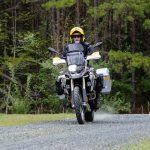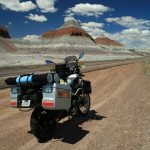Avon TrekRider Tyre Review
Nothing is as important as choosing the right tyres for your bike and for the riding you want to be doing.
When you look at forums and threads on Facebook and so on, ‘What tyres should I choose?’ is a question that’s frequently asked. Sometimes I’m a bit shocked at the response the questioners get from more experienced riders. I’m a great believer that the only stupid question is the question that isn’t asked.
But I’m fascinated by the responses of those who take the time out to make suggestions. Woven into those suggestions are some great points! Of course, everyone has a favourite tyre and will suggest that. Others haven’t been impressed with options they have tried and will comment on that. Excellent.
I’m a fan of Avon tyres and have been riding on them since 1995 or thereabouts. I started off on Avon’s Gripsters and loved them. For the final 4 years of the big trip they were my tyres of choice. When Avon stopped making the Gripsters I was really disappointed; I tried a wide range of other manufacturer’s tyres before I’d found the Avons and there were good ones, but nothing hit the same mark. What to do?
It wasn’t long before I learnt that the reason Avon had called a halt to their production of the Gripsters was that design, technology and materials meant that a new tyre was possible, and needed. They introduced me to the 50/50 TrekRiders. I have to admit to being a bit negative about having to change, but willing to have a go. I also admit to grumbling into my helmet for the first 50 miles on the new tyres.

Birgit and I headed for Portugal. This is one of the riding delights of Europe and we knew that not only would our Overlanders curiosity itch be scratched but there would be ample opportunity to really test the 50/50 aspect.
There are hundreds of dirt roads and the joy of Portuguese law is that if it’s a road you can ride it; even dirt. Endless hours away from anything to do with asphalt are possible. Portugal’s back roads are excellent too. Out of season they are peaceful, and reminded me of New Zealand in that I had the feeling that every time we went around a corner there was something beautiful or fascinating to look at.


They aren’t knobblies though. In deep sand they were nothing like as good. The trade-off of course is tyre wear of knobblies in comparison; especially when used on asphalt.
I like the TrekRiders so much that I’ve put them on my BMW F800GS in the USA. The roads there would give them a different kind of test. The riding style is dramatically different to that of Europe. At home we have a lot of ‘stop-start’ riding due to the smallness of the roads, the number of junctions and the density of the traffic. In the USA the roads are more open and the demands on the tyres are very different as a result.

The tyres are tubeless but out of habit I’ve been running tubes on both bikes. I’ve been able to go down to 20psi on the sand and the grip has been surprisingly good! The stiffened sidewalls mean that I didn’t see even a hint of the tyres coming off the rims, or of tyre slip.
The TrekRiders on the F800GS taught me they have a recommended tyre pressure for a reason. I didn’t have the front tyre to the right pressure for the first couple of thousand miles. Don’t ask… At less than recommended 41psi , one edge of the tread on the front tyre wore first. Note to self. Be more observant!

Avon TrekRiders – Do they have your size?
